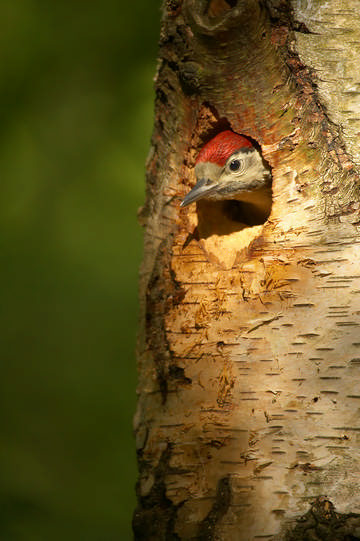
Great Spotted Woodpecker © Carolyn Chase
This always has been the most familiar woodpecker but in the last twenty years its numbers have risen considerably, with the UK breeding index almost doubling in the period 1984-2004, and it has expanded its range. During this Atlas Great Spotted Woodpeckers were found in 588 tetrads, a net gain of 86 since our First Atlas, and they are now present almost everywhere. There are three main newly occupied areas: in the north of Cheshire, along the Mersey valley; in the eastern hills, where they were found in nine new tetrads, and were absent from only three of the bleakest squares; and widely across the agricultural south of the county. The latter has been possible because many birds have spread out from their core woodland areas and are now are using hedgerow trees.
The habitat codes show more than two-thirds of records (69%) in woodland, nearly all of them in broadleaved or mixed woodland, with just six records in coniferous and 26 in waterlogged (carr) woodland. 3% of records came from scrub, 15% were in farmland and 12% in human sites: urban areas are no bar to this species, as seen from their distribution map.
Breeding Great Spotted Woodpeckers go through a cycle of conspicuousness. They are very noticeable when displaying, from early in the new year, making their far-carrying ‘drumming’ sound by rapidly hammering a suitably resonant piece of timber. Similarly, when excavating their nest-holes, the noise draws attention to their activities, but they can be very secretive when laying and incubating. As soon as the chicks hatch, however, they start a continuous racket which carries on throughout daylight hours for the three weeks that they are in the nest, intensifying whenever they hear a parent returning with a beakful of food.
This behaviour means that it is very easy to prove breeding. On a quiet morning in Delamere Forest, I have several times been able to find five or more nests in an hour, just by listening for chicks and moving off in the direction of the next noisy brood, with nests typically spaced from 250 m to 400 m apart, territory sizes of 5 or 10 ha. They have significantly advanced their breeding season in the last twenty years, from hatching in late-May or early June to mid-May in some years nowadays.
Breeding was confirmed in 354 tetrads, and in more than half of them (181) fieldworkers found a nest, although few reported the species of tree: 5 birch, 2 oak and 1 alder. In Delamere Forest they favour birch, particularly trees where the core is being rotted by birch bracket polypore fungi, and Scots or Corsican Pine, often using live trees. They normally use the trunk of the tree about 5 metres above the ground. Some trees contain several woodpecker holes or trial borings, but birch is seldom suitable two years running as it rots quickly. It is always worth keeping an eye on old woodpecker holes, because they are often used by other species in the next year and Great Spotted Woodpeckers obviously play an important role in woodland ecology.
In 116 tetrads observers noted recently-fledged birds, the adults in June often taking their red-headed youngsters on a tour of suitable feeding sites including peanut feeders in gardens. Their natural food is mostly insects hidden under bark or in dead wood, especially the larvae of longhorn beetles, but they also take tree seeds and birds’ eggs, often hammering their way into a nest box occupied by a brood of tits.
The BTO BBS analysis shows that the breeding population of Cheshire and Wirral in 2004-05 was 1,970 birds (930-3,010), corresponding to 3.3 birds per tetrad in which the species was found, or 4.6 birds per tetrad with confirmed or probable breeding. The areas of best woodland habitat often contain five pairs, so to reach that average figure across the county, there must be many suboptimal tetrads with only one pair.
Sponsored by Chester and District Ornithological Society

